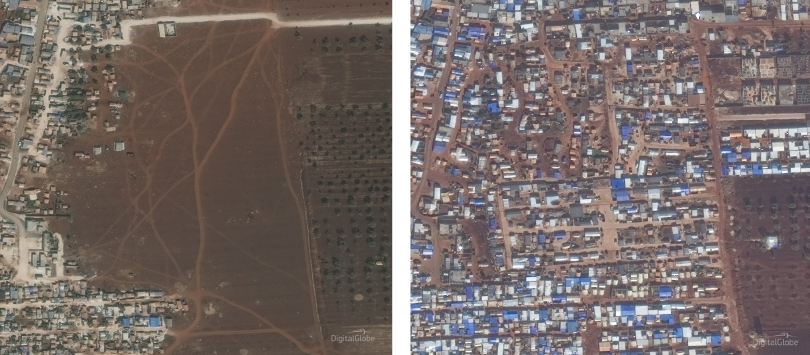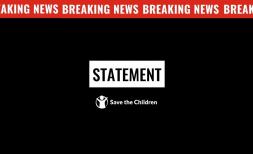New analysis reveals scale of destruction and displacement in Idlib: Civilians forced into shrinking space as conflict intensifies

- New satellite imagery and analysis by the Harvard Humanitarian Initiative, Save the Children and World Vision show how children are experiencing unbearable suffering.
- Nearly one-third of the buildings examined in two frontline towns have been severely damaged or destroyed, making it almost impossible for civilians to return to their homes.
- Images show an increase in size of 100% and 177% in two displacement camps in northern Idlib since 2017, as the conflict enters 10 years.
- The full briefing and satellite imagery analysis is available to download here.

Between September 2017 and December 2019, the area of this displacement camp in Idlib doubled. More satellite imagery is available here.
Conflict has forced nearly a million people, more than half of them children, to flee from 45 percent of Idlib governorate in North-West Syria, pushing them into inhumane living conditions in overcrowded camps.
As the conflict enters its tenth year on March 15th 2020, the Harvard Humanitarian Initiative, Save the Children and World Vision are releasing new analysis today looking at the civilian and humanitarian impact of the renewed military offensive launched in April 2019. Nearly one million people have been forced to flee their homes since the start of December 2019 alone.
A series of satellite images, analysed by the Signal Program at Harvard Humanitarian Initiative, show that several areas in the South and East of Idlib governorate have been intensely damaged by the offensive. In the areas examined, the researchers estimate that nearly one-third of buildings have been significantly damaged or destroyed. With most of these areas inhabitants having fled before or during the offensive, the destruction of homes and vital civilian infrastructure will make it nearly impossible for families to return in the near future, according to the aid organisations.
Another set of images show two displacement camps in North Idlib that have more than doubled in area since 2017. The informal and formal camps are seen spreading over what was previously agricultural land. In both camps, population density appears to grow acutely between 2018 and 2019, with significant increases over the last year.
Othman*, 9, whose family now lives in a displacement camp, said:
“We left [our home] because of the attacks, we left in a car and came here. We couldn’t find anywhere to settle in. We stayed in a mosque first, then they brought us here. All my friends are gone, there’s no one left in my town. They’ve killed everyone there.”
Fadi*, 15, lost his arm in an airstrike and had to flee his village:
“The attacks were vicious. We couldn’t take anything with us except mattresses, blankets and some of our clothes. When I lost my arm, I felt as if I were dead. Now, I carry bricks with my brother using one arm to help provide for my family.”
Caitlin Howarth from the Signal Program at Harvard Humanitarian Initiative said:
“We reviewed imagery from 2017 to 26 February 2020, assessing changes in areas that have been targeted and others that are receiving displaced populations. During that period, some areas appear to have been rendered largely uninhabitable, with key infrastructure and populated areas heavily impacted by aerial bombardment and ground fighting. We cannot fully and accurately calculate inhabitable areas and empty land solely via satellite imagery analysis – however, the mass displacement and destruction of previously inhabited areas mean that the humanitarian crisis has de facto been compounded. This population is still at more than 3 million, and one third of it has moved in three months.”
Sonia Khush, Syria Country Director for Save the Children, said:
“Relentless bombardment has all but emptied out large parts of Idlib in a matter of weeks, with catastrophic consequences for hundreds of thousands of children and women. Half a million children are crammed in camps and shelters at the border with Turkey with no access to the basics of a decent life: a warm place to sleep, clean water, nutritious food, and education. Families are being squeezed beyond breaking point and our partners on the ground are overwhelmed by the scale of the needs. Unless we see a dramatic de-escalation, the tenth year of this conflict could be one of its bloodiest. The world cannot continue to watch and wait while children are killed, injured and displaced on such a massive scale.”
Johan Mooij, World Vision Syria Response Director, said:
“Children come to us on a daily basis in Syria hungry, cold, and deeply distressed by what they have witnessed and experienced. Many of those living in Idlib now come from other parts of Syria and have known nothing but displacement and war in their short lives. Boys and girls aged five or six can name every type of bomb by its sound, but sometimes can barely write their name having missed out on the chance of an education. No child should ever be forced to experience the suffering and upheaval these children have. We are working to support them but cannot reiterate enough: only a lasting ceasefire can put an end to this misery.”
The research comes as North-West Syria experiences the worst humanitarian crisis in the nine-year conflict. Children are the first victims of this conflict: according to the United Nations, at least 77 children were killed or injured in the North-West in the first month of 2020. On February 25th, ten schools and kindergartens were reported to have been bombed in Idlib, killing nine children and injuring dozens. An estimated 280,000 school-aged children in the area have had their education severely impacted.
Save the Children and World Vision are calling on all warring parties to respect international humanitarian and human rights laws. All sides need to protect schools, hospitals and other vital civilian infrastructure from attacks, and avoid the use of explosive weapons in populated areas. Particular efforts should be given to protecting children, who are extremely vulnerable to the impact of explosive weapons. They also ask all warring parties to allow unhindered and safe access to aid workers.
For the international community, this must be a watershed moment that puts renewed focus on finally securing a peaceful end to the crisis and rehabilitating Syria’s lost generation of children. The UN Security Council and states with influence must show they have the political will to do more to protect children.
Notes to Editors:
- Two significant military offensives were launched in northern Hama, southern Idlib and West Aleppo that have led to massive displacement of civilians: one between April and August 2019 and the second one has been ongoing since December 2019.
- The estimated reduction in the territory where the majority of the population of Idlib is living – more than 45% - was calculated based on maps and open source material available from March 2019 and February 2020. It represents changes in territorial control where the Government of Syria has retaken an area, and the majority of the population have left and moved further north.
- Though there have been changes in the land size, the population is still approximately the same: more than 3 million people, including 50% children.
- Save the Children's work saves and improves children's lives around the world. We work to ensure children have healthcare, food and shelter, as well as learning and child protection services when children need it most. We are committed to helping all children achieve their full potential by ensuring they grow up healthy, receive a good education, and stay safe.
- World Vision is a global aid agency supporting children and families across the countries affected by the Syria Crisis. In North-West Syria, with our partners we are supporting more than ten medical facilities, protection activities, vital water and sanitation provision, and emergency support with shelter, winter kits, and basic goods.
- The Signal Program on Human Security and Technology at Harvard Humanitarian Initiative is part of the Harvard T.H. Chan School of Public Health. Since 2012, the Signal Program has advanced the safe, ethical, and effective use of information communication technologies by communities of practice during humanitarian and human rights emergencies. Harvard Humanitarian Initiative conducts research and education to empower communities in crisis. Learn more at https://hhi.harvard.edu/research/signal.
- * All names have been changed to protect identities.
For interviews, please contact:
- Harvard Humanitarian Initiative: Caitlin Howarth, chowarth@hsph.harvard.edu, +1 (617) 384-5640.
- Save the Children: Joelle Bassoul, Joelle.bassoul@savethechildren.org, +961 81600696
- World Vision: Caroline Anning, caroline_anning@wvi.org, +962 778482439





